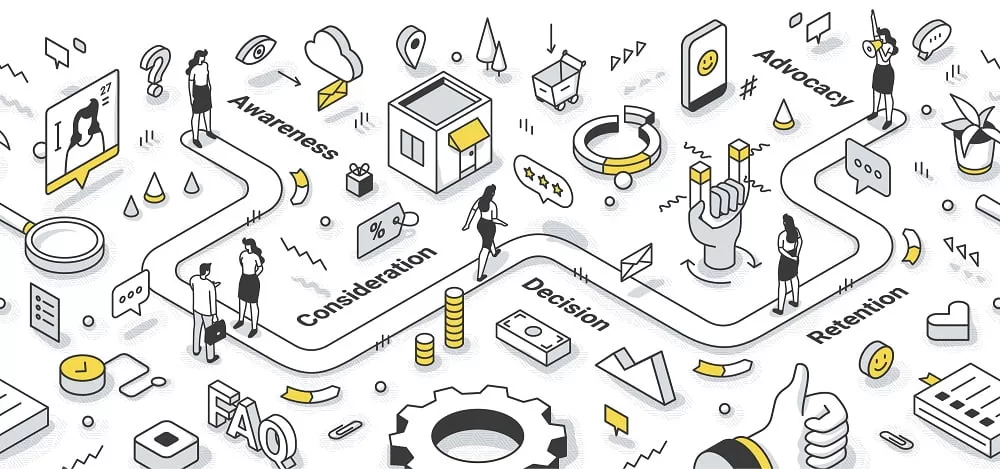Today, all brands spend a lot of effort on customer journey maps, that is, creating new customers and retaining their existing customers. From the moment of entering the customer’s radar to the phase of loyalty and advocacy, every touch matters. At every stage, it is necessary to approach the people with whom we are in contact with the right strategy and actions.
In this article, we will detail this concept for you and discuss why you need to pay attention to the customer and buyer journey while creating your marketing strategies.
What is a Customer Experience Map? Let’s Get to Know the Concept
The concept of customer experience map also appears in the marketing world as a customer journey or customer journey map. What is meant here is the mapping of the phases of being a customer from the moment a brand first touches the consumer, staying as a customer, being satisfied enough to make the purchase again, and the behavioral models in these processes. We can also summarize this concept as presenting a holistic experience of end users. It is among the most basic elements of success for marketers to create the right customer experience for their products and to apply the right strategies for each stage. At this point, details such as using the right channels for the relevant phase and sharing the right content at the right time come to the fore.
The Importance of a Customer Journey Map
As we know, with the advances in marketing technologies, it has become quite easy to gather useful information in the fields of marketing and sales. At this point, the customer journey map came into play.
The fact that consumers contact brands by leaving a trace behind them in digital as well as physical areas, and doing this by leaving a trace behind, allowed the marketing and salesmen to set up their campaigns for higher success rates. The customer journey map is a key success factor here.
Today, brands can identify their potential customers and how ready they are to buy. If marketers shape their campaigns according to the phases customers are in, this both increases and accelerates the conversion rate of their potential customers into customers.
For this reason, customer analysis has become very important in the marketing world. It has become an inevitable strategy to identify people at different stages from the analysis and to try to take relevant actions. Now, marketers make their relevant campaigns more effective by modeling how their potential and existing customers go through the stages in their brand communications and by making the necessary segmentations.
What Stages Are in Customer Journeys?
Customer experience consists of two concepts: Buyer Journey and Customer Journey. While the Buyer Journey covers your potential customer’s discovery, interest, evaluation and decision making, the customer journey covers the stages of starting to use the product, retaining the customer and creating advocacy. Between these two concepts, we can say the intersecting cluster for the part of being a customer and starting to use the product.
We can summarize the stages of these journeys, which are accepted all over the world, as follows:
1) Awareness – Discovery Phase
The first step of the prospects is the moment they first meet with the brand. In pre-Internet days, aggressive outbound marketing techniques were at the forefront regarding the creation of leads. We now observe more communication flowing from the customer to the brand thanks to inbound and content marketing. In other words, in today’s world, it is very important to create useful and entertaining content, get high scores from comments and implement effective SEO strategy. In addition, advertising and PR work flowing from the brand to the audience are also used intensively in the awareness stage. The main goal is to persuade prospects to leave you their contact information with their own consent, providing this opens the door to other stages. Especially considering that we are approaching a world without cookies, it is very valuable for end users to share information with their own consent.
2) Consideration Phase
During the evaluation phase of the customer journey map, actions for users who are interested in the brand come to the fore. It is among the duties of marketers to poll this audience with timely and content information through channels such as e-mail, push notification, SMS or chatbot and direct them towards sales. The length of the process here may vary depending on whether the business is B2B or B2C, the sector and product-service characteristics. It is important to dominate the dynamics in the sector in which it competes and to create a communication strategy accordingly.
3) Decision – Purchase Phase
At this point, the phase where customer acquisition takes place comes into play. It is an important mistake to think that the final goal is achieved by purchasing a product or service in the business world, and new customer communication is a factor that has a positive or negative effect on company revenues. The smooth completion of the phase of becoming a customer and the provision of accurate information are among the factors that will affect the lifetime of the customer journey map. Strategies that will establish a long relationship with the customer should also be planned use at this point.
4) Retention Phase
Customer retention is one of the most important elements of the customer journey map. Statistics around the world show that customer retention is more profitable than trying to acquire new customers. In this context, it is important that the right loyalty programs are created, and the customer success management is carried out properly, as well as the fact that the campaigns and notifications on these issues are kept on point. Ensuring the integrity of experience at every point where the customer meets the brand allows the relationship to be long-term.
5) Advocacy Stage
Undoubtedly, every brand wants customers who follow it like a fan but leaving the fans without special attention weakens the relationship bonds. Processes related to a loyal customer are also an important part of the customer journey map. Again, effective use of digital channels and physical points and creating special campaigns and privileges for the relevant audience are among the actions taken at this stage. For example, special promotions such as presenting the new version of a favorite model to the fan base can make a difference. It is possible to say that this segment is the most important part of the audience that increases the profitability of brands, so the necessity of special communication emerges.
Map Your Customer Journey with SmartMessage Journey Manager
After the digital revolution in the marketing world, customer analysis has become very important. Consumers are now communicating with brands too much through digital channels as well as physical points. They leave traces to companies in moments of communication. The customer journey map provides significant benefits in making sense of these traces at different stages and taking the relevant actions. Being able to model how leads or customers go through brand communications is an invaluable action for a marketer. Getting this picture right will make the segmentations and related campaigns to be created more effective.
With SmartMessage Journey Manager, you can easily map your customer journey for your potential and existing customers and set up various personalized and scheduled campaigns and automations for your customers at every stage and stage. Click to see the details of our product.


